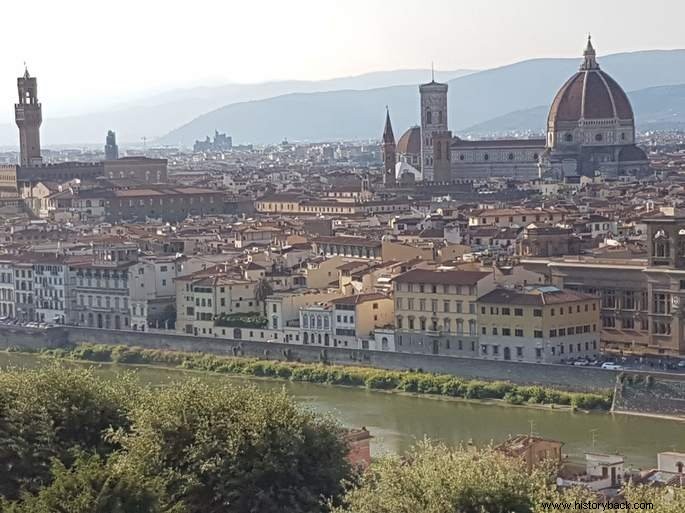The Cultural Renaissance was a movement that began in the Italian Peninsula in the 14th century and spread throughout Europe until the 16th century.
This phase coincides with the prosperity of the cities of the Italian Peninsula, especially Florence, where wealth allowed investments in the production of works of art.
Renaissance artists and thinkers expressed in their works the new vision of the world brought with Humanism and the revaluation of Classical Antiquity.
Origin of the Renaissance

At the end of the Middle Ages, the bourgeoisie, that is, merchants and artisans, became rich and became patrons, sponsoring the construction of palaces and churches. Their orders could be individual or carried out through professional associations that demanded sculptures and paintings to show their prosperity.
The existing works in the Italian Peninsula, favored for having been the seat of the Roman Empire, inspired the artists of the Renaissance. The literature, sculpture and philosophy of Greco-Roman antiquity served as a reference for Renaissance writers and contributed to the formation of their values and ideals.
See also :Patronage
Characteristics of the Renaissance:Summary
The Renaissance rejected feudal values such as theocentrism, mysticism, geocentrism, and collectivism. In the Middle Ages, much of the intellectual and artistic production was linked to religion. In the Modern Age, art and knowledge turned to the concrete world and the human being's ability to transform it.
However, this does not mean that religion was devalued, but questioned. Therefore, new forms of devotion emerged in this period and there was a great renewal of religious orders, for example.
One of the hallmarks of the Renaissance was rationalism. Based on the conviction that everything could be explained by reason and the observation of nature, an attempt was made to understand the universe in a calculated and mathematical way.
A crucial element was humanism, in the sense of valuing the human being, considered the most perfect work of the Creator. Hence the Renaissance anthropocentrism, that is, the idea of man as the center of intellectual and artistic concerns.
Plato's philosophy was reinterpreted and given the name Neoplatonism. This advocated spiritual elevation, the approach to God through an interiorization to the detriment of any material pursuit.
See also:Characteristics of the RenaissanceArtistic Renaissance
The first artistic manifestations appeared with Giotto di Bondoni (1266-1337). His works represented human figures with great naturalism, including Christ and the saints.
The Quattrocento (1400), second period of the Italian Renaissance, appears in Florence with the painter Masaccio (1401-1429), a master of perspective.
It is also necessary to mention Sandro Botticelli (1445-1510), who believed that art was at the same time a spiritual, religious and symbolic representation. He is the author of the first female nude performed since antiquity, "The Birth of Venus" (1483).
Also noteworthy were the architect Felippo Brunelleschi, author of the dome of the Cathedral of Santa Maria del Fiore, the sculptor Donatello and the painters Paolo Uccello, Andrea Mantegna and Fra Angelico.
Other Renaissance painters are:
- Leonardo da Vinci (1452-1519), author of works such as the "Mona Lisa" and "The Holy Supper";
- Rafael Sanzio (1483-1520) known as the "painter of the Madonnas";
- Titian, the master of color, who made his mark on the Venice school;
- Michelangelo, sculptor and painter known as "the giant of the Renaissance", responsible for the monumental frescoes in the Sistine Chapel. The sculptures of "David", "Moses" and "Pietá" are also his.
Literary Renaissance
The consolidation of the Renaissance in Italy took place basically in the 14th century, a period known as Trecento , ie in the 1300s.
A great precursor of the literary Renaissance in Italy was Dante Alighieri (1265-1321), author of "The Divine Comedy". Despite criticizing the Church, his work still shows strong medieval influence.
In the literature, the use of the Tuscan dialect was generalized, which would be the matrix of the contemporary Italian language. But it was Francesco Petrarca (1304-1374) the "father of humanism and Italian literature". He was the author of "Africa" and "Odes to Laura", reconciling Greco-Roman inspiration with medieval religiosity.
Another great name of the Trecento was Bocaccio and his work "Decameron", where his satirical tales criticized medieval asceticism.In the third period, the Cinquecento (1500), Rome became the main center of Renaissance art. St. Peter's Basilica was built in the Vatican, designed by architect Donato Bramante.
Rebirth - All MatterTo complement your research on the topic, also read the articles :
- Artists of the Renaissance
- Phases of Rebirth
- Renaissance:Characteristics and Historical Context
- Artistic Renaissance
- Urban Renaissance
- Commercial Renaissance
- Scientific Renaissance
- Renaissance Humanism
